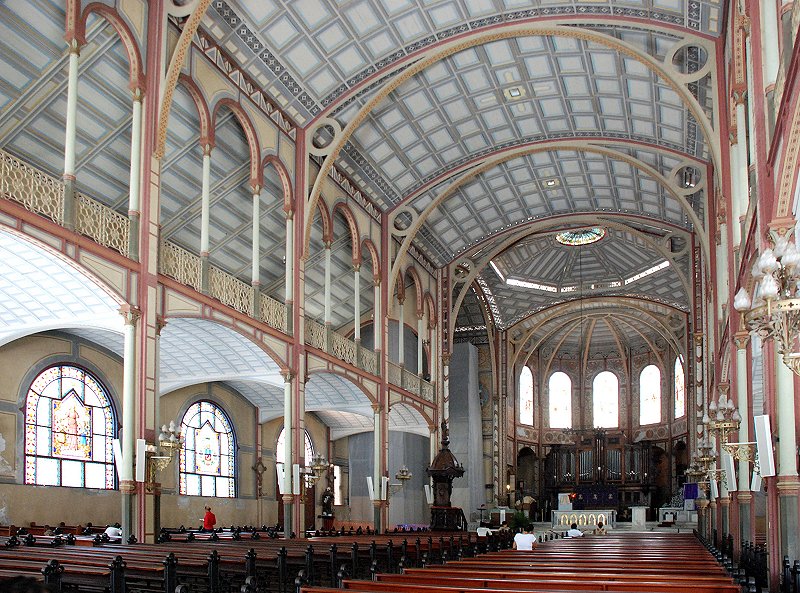Fort-de-France Cathedral on:
[Wikipedia]
[Google]
[Amazon]
St. Louis Cathedral () is a Catholic cathedral located in Martinique, an

overseas department
The overseas departments and regions of France (french: départements et régions d'outre-mer, ; ''DROM'') are departments of France that are outside metropolitan France, the European part of France. They have exactly the same status as mainlan ...
of France. It was built in the late 19th-century in the Romanesque Revival style and serves as the cathedral of the Roman Catholic Archdiocese of Fort-de-France. The church is situated in the downtown area of the capital Fort-de-France
Fort-de-France (, , ; gcf, label=Martinican Creole, Fodfwans) is a Communes of France, commune and the capital city of Martinique, an overseas department and region of France located in the Caribbean. It is also one of the major cities in the ...
, at the intersection of rue Victor Schœlcher and rue Blénac.
The construction of the cathedral began in the mid-17th century and it opened in 1657. Due to the natural disasters that have plagued Fort-de-France over the years, the current structure dates back to 1895 and was built with an iron frame in order to withstand these calamities. It is the seventh church to be erected on the site; it was built by Pierre-Henri Picq.
History
Before the present cathedral was completed in 1895, a total of six churches had previously been constructed on the site, the first of which was built in 1657. These were all destroyed by either fire, earthquakes or hurricanes. The loss of significant buildings was not uncommon inFort-de-France
Fort-de-France (, , ; gcf, label=Martinican Creole, Fodfwans) is a Communes of France, commune and the capital city of Martinique, an overseas department and region of France located in the Caribbean. It is also one of the major cities in the ...
, as devastating natural disasters frequently plagued the region. The cathedral that immediately preceded the present one was destroyed by fire in July 1890, a disaster that also obliterated three-quarters of the town. Pierre-Henri Picq was hired to be the architect.
In the mid-1970s, the cathedral underwent an extensive program of restoration and refurbishment. Part of this entailed repainting the exterior to a tan and brown colour. The renovation was completed in 1978. The cathedral is one of the most famous landmarks in the capital and has been labelled "the religious centrepiece" of Martinique.
Architecture

Exterior
St. Louis Cathedral was built in aGothic Revival
Gothic Revival (also referred to as Victorian Gothic, neo-Gothic, or Gothick) is an architectural movement that began in the late 1740s in England. The movement gained momentum and expanded in the first half of the 19th century, as increasingly ...
style with rounded arches in the Neo-Romanesque style. The cathedral's façade features a steeple that rises above the city, while its exterior walls are supported by flying buttresses. Located in front of the cathedral is a small square that contains two royal palms which appear to flank the structure. The building is located directly across the square from the consulate of the United States and is one block northwest from the park La Savane
La Savane is a 12½ acre park located on the Fort-de-France Bay in Martinique. It was formerly known as Jardin du Roi (garden of the king) and its first purpose is said to have been to harbor scientific experiments on plants that were new to the ...
.
The entire structure has a frame of iron beams which support the walls, ceiling and steeple making the church a fine example of architecture from the time of the Industrial Revolution. As a result, the cathedral is referred to in the Caribbean
The Caribbean (, ) ( es, El Caribe; french: la Caraïbe; ht, Karayib; nl, De Caraïben) is a region of the Americas that consists of the Caribbean Sea, its islands (some surrounded by the Caribbean Sea and some bordering both the Caribbean Se ...
as the "Iron Cathedral" and has been compared to a "Catholic railway station".
Interior
The interior of the church is noted for its "grandorgan
Organ may refer to:
Biology
* Organ (biology), a part of an organism
Musical instruments
* Organ (music), a family of keyboard musical instruments characterized by sustained tone
** Electronic organ, an electronic keyboard instrument
** Hammond ...
", ornate walls, beautiful stained glass windows and balustrade
A baluster is an upright support, often a vertical moulded shaft, square, or lathe-turned form found in stairways, parapets, and other architectural features. In furniture construction it is known as a spindle. Common materials used in its con ...
made of iron.
Located underneath the choir loft is a crypt
A crypt (from Latin ''crypta'' "vault") is a stone chamber beneath the floor of a church or other building. It typically contains coffins, sarcophagi, or religious relics.
Originally, crypts were typically found below the main apse of a chur ...
containing the tombs of several previous governors of Martinique
A governor is an administrative leader and head of a polity or political region, ranking under the head of state and in some cases, such as governors-general, as the head of state's official representative. Depending on the type of political r ...
.
References
External links
{{Portal bar, Catholicism, Caribbean, France, Architecture Roman Catholic cathedrals in Martinique Fort-de-France Monuments historiques of France Roman Catholic churches completed in 1895 19th-century Roman Catholic church buildings in France